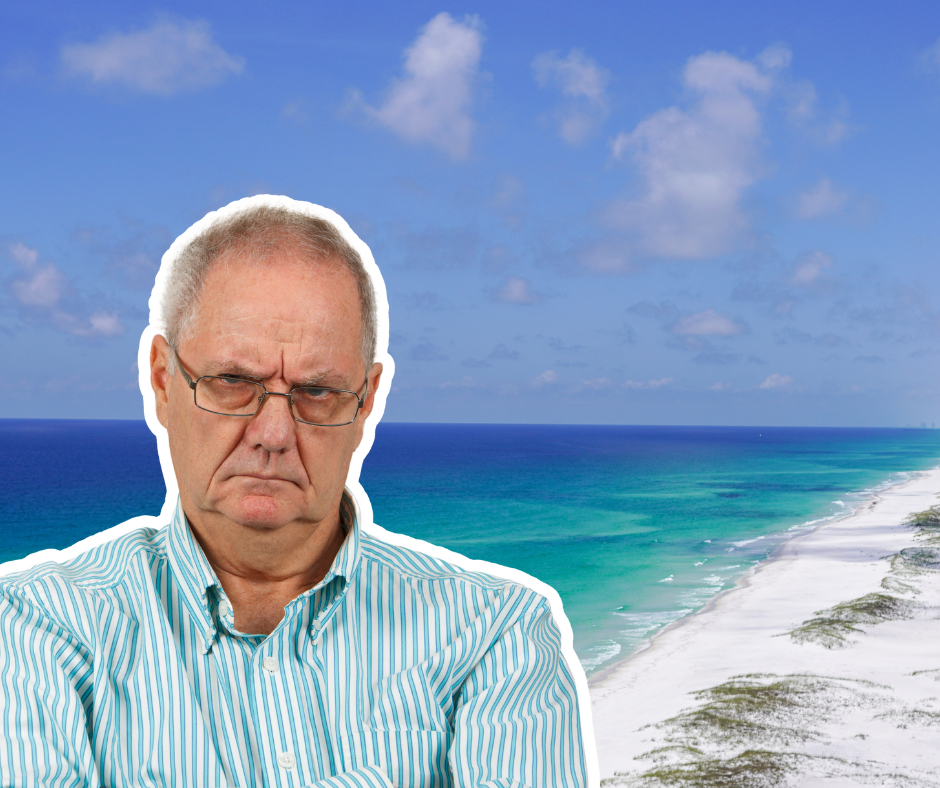
🌴 Beach Access Disputes Continue: Senate Bill 1622 does not immediately change access rules, despite public perception that it would restore “customary use” rights.
📏 Unclear Boundaries: Residents and tourists are confused about where public access ends and private property begins due to lack of visible markers like the Erosion Control Line.
🗣️ Public Frustration Grows: Reports of inconsistent enforcement and confrontations with vendors and law enforcement have added to public dissatisfaction and tourism concerns.
Walton County residents not owning beachfront property or for those living in a large community near 30A without gated or private beach entrances claim finding a spot to place beach chairs, towels, and an umbrella has become complex.
The passage of Senate Bill 1622 gave residents hope that “Customary Use” would remove the privatization and restriction of the use of beachfront property by the public they enjoyed before 2018.
That is not the case.
To quote Acting County Attorney for Walton County, Clay Adkinson, “On Day 1 [regarding the implementation of Bill 1622 becoming law,] nothing changes.” The new law, when it’s either signed by the governor or allowed to become law without his signature, will not change anything regarding ownership and land use of those beachfront properties.
An analysis of the bill by staffers of the Florida Senate explains that the bill returns the process to have customary use on a beach to the pre-2018 method, which means:
Previous to this 2024 bill (so, how the process worked from 2018-2024 in Walton County) this is how customary use worked:
The significantly less talked about portion of the bill is its erosion control provisions.
The bill also provides that, in counties with populations of less than 275,000 that also have three cities the following happens as well:
Well, that’s still getting worked out.
Many thought the bill would give greater access to the beaches of South Walton County. [according to whom?] The focus of the bill’s goal is to diminish the erosion of beaches. “As it has been determined that beach erosion is detected in many counties, including Walton County. The bill [soon to be law] will require the Board of Trustees of the Internal Improvement Trust Fund to adopt the ‘Erosion Control Line’ (ECL) by resolution in certain circumstances authorizing the Department of Environmental Protection to proceed with certain beach restoration projects.”
With terminology like Mean Water Line and Erosion Control Line (ECL), where exactly can a beachcomber sit and enjoy the sun and sand? If you ask this question to Walton County Code Enforcement officers, a vendor selling chair and umbrella rentals, or a private beachfront homeowner, you may, more than likely, still get three very different answers. According to citizens attending the Walton County Commissioners meeting this week, one of the most common answers is: “You need to move on. This is private property.”
Walton County resident Dave Rauschkolb asked Interim County Attorney Adkinson to cut through the word salad and red tape around the bill and explain in layman’s terms what happens now – and next.
Rauschkolb also shared that the public space below the ECL and/or the mean high water line should not be considered a ‘transitory zone.’ He suggested that many think the space below the ECL should only be used to move through and onto a completely public beach. Rauschkolb added, “People who rent a beach chair or rent a house across the street from the beach and they come down the public beach access and then they [find that they] are immediately accosted. And in some places [accosted] by beach chair vendors who are hired by private entities. And they [the visitors] are told you can’t sit here. Well,[with that treatment] those folks [tourists] aren’t going to come back. [They think…] We are not coming to this beach anymore.” Rauschkolb talked about one issue that was attributed to the decline in his vacation rental business, retail sales, real estate sales, and restaurant income.
Another citizen, Sarah Day, who had been at the beach that day shared her encounter with a Sheriff’s Deputy earlier that day. As Ms. Day was in the sand near the water, the Deputy said to her, “Public is only allowed on wet sand. Specifically, where the tide is actively touching the chair, towel, or even feet.” She added that, “The implication was that if you are not in the water, you are not in public space.” She told the BCC that this was the second time someone had hassled her in the last week.
Adkinson explained that what happened to Day was not protocol and inferred that Code Enforcement had been trained on proper ECL procedures. He continued to say several times, “This is not accurate.” He offered to support Ms. Day by joining her on a conference call with the Sheriff’s General Council to resolve the problem.
Overall, the problem of public use on privately owned beaches is complicated to understand and even harder to gauge due to limitations that there are no visible markers to help clarify where set boundaries are.
Register or login with Mid Bay News and never get another pop up on our site!